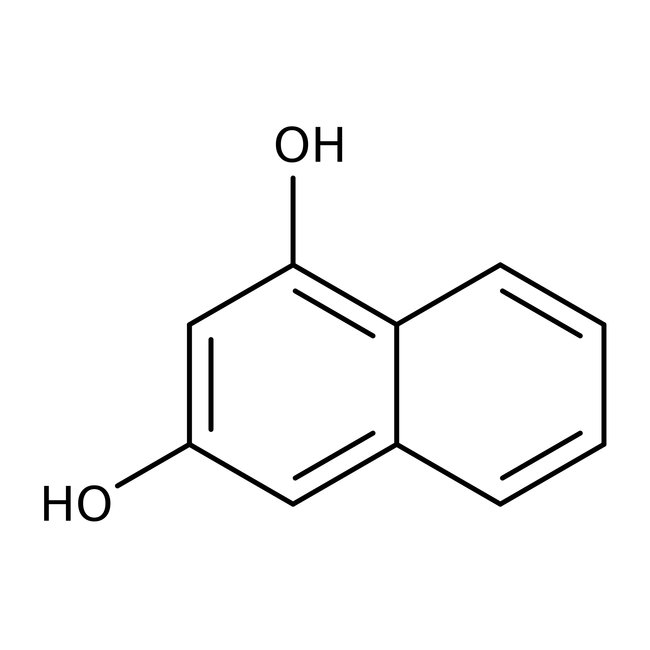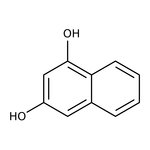Search Thermo Fisher Scientific
Thermo Scientific Chemicals
1,3-Dihydroxynaphthalene, 98%
CAS: 132-86-5 | C10H8O2 | 160.172 g/mol
| Catalog Number | Quantity |
|---|---|
| ALFA17739.06 | 5 g |
Catalog number ALFA17739.06
View Price:Sign InSign in to see your account pricing. Need an account? Register with us today.
Quantity:
5 g
Specifications
Chemical Name or Material1,3-Dihydroxynaphthalene
CAS132-86-5
Health Hazard 1H302-H315-H319-H335
Health Hazard 2GHS H Statement
H341-H315-H319-H335
Suspected of causing genetic defects.
Causes skin irritation.
Causes serious eye irritation.
May cause respiratory irritation.
H341-H315-H319-H335
Suspected of causing genetic defects.
Causes skin irritation.
Causes serious eye irritation.
May cause respiratory irritation.
Health Hazard 3P261-P264b-P270-P271-P280-P301+P312-P302+P352-P304+P340-P305+P351+P338-P312-P330-P332+P313-P362-P501c
View more
It is used in the naphthoresorcinol test for uronic acids of Tollens and Rorive, a blue color can be extracted with ethanol after heating of uronic acids with naphthoresorcinol in hydrochloric acid. It is also employed as a reagent for various medical tests. It can also be used as a spot test reagent for glycerate.
This Thermo Scientific Chemicals brand product was originally part of the Alfa Aesar product portfolio. Some documentation and label information may refer to the legacy brand. The original Alfa Aesar product / item code or SKU reference has not changed as a part of the brand transition to Thermo Scientific Chemicals.
Applications
It is used in the naphthoresorcinol test for uronic acids of Tollens and Rorive, a blue color can be extracted with ethanol after heating of uronic acids with naphthoresorcinol in hydrochloric acid. It is also employed as a reagent for various medical tests. It can also be used as a spot test reagent for glycerate.
Solubility
Soluble in ethanol (50 mg/ml), and water.
Notes
Light Sensitive. Store away from oxidizing agents and bases. Keep the container tightly closed in a cool, dry and well ventilated place.
It is used in the naphthoresorcinol test for uronic acids of Tollens and Rorive, a blue color can be extracted with ethanol after heating of uronic acids with naphthoresorcinol in hydrochloric acid. It is also employed as a reagent for various medical tests. It can also be used as a spot test reagent for glycerate.
Solubility
Soluble in ethanol (50 mg/ml), and water.
Notes
Light Sensitive. Store away from oxidizing agents and bases. Keep the container tightly closed in a cool, dry and well ventilated place.
RUO – Research Use Only
General References:
- Grant R. Bartlett. Calorimetric Assay Methods for Free and Phosphorylated Glyceric Acids. Journal of Biological Chemistry,1959,234(3), 469-471.
- Antonın Lyčka.; Zdeněk Vrba.; Martin Vrba. 15N, 13C and 1H NMR spectra and azo-hydrazone tautomerism of some phenylazo compounds derived from 1,3- and 1,5-dihydroxynaphthalene.Dyes and Pigments,2000,47(1-2), 45-51.



